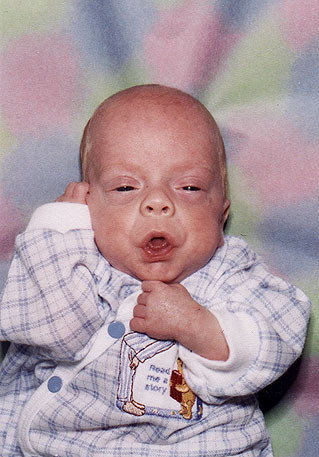
My going home picture
Scott's Life and Times In the NICU
His experiences and treatments as written between October 25, 1997-February 4th, 1998

 VISIT SCOTT'S DIARY PAGES, LIFE AFTER THE NICU
VISIT SCOTT'S DIARY PAGES, LIFE AFTER THE NICU CLICK HERE FOR PREEMIE LINKS PAGE
CLICK HERE FOR PREEMIE LINKS PAGEHello..The purpose of this page is to tell the story of my son,Scott. He is currently in NICU and is doing well. I thought this would be a great way to report his progress,as well as letting others get a feel of what it is like to be a parent of a child in the NICU. I will explain terms, conditions, what to expect as a parent when the nurses and doctors are talking about all the different things that may go on while the premature baby is in the nicu. I really hope this helps others who may have questions about NICU. Neonatal Intensive Care Unit.
For starters, Scott was born just in his 25th week of gestation. That is 15 weeks early.At 25 wks he is pretty well developed but the lungs and brain are the last main organs that are in need of developing. My wife was recieving medicine to help develop his lungs. My wife had an incompetent cervix and that ultimately led to Scott's premature birth. Incompetent cervix is when the cervix does not keep its form and ultimately, the cervix starts to dilate and this causes the uterus to start going on with the birthing process. When it is known that the mother may have an incompentant cervix, her doctor can put in a stitch to tighten the cervix. This will then proceed to keep the cervix from dilating and allowing the uterus to go into premature birthing status.
Scott was born weighing 1pound and 8 oz. He was immediately evaluated and then was intubated. Intubation is when a tube is put down the trachea and this is what allows the ventilator to "breathe" for the newborn. The premature newborn, as in Scott's case, may be on the "vent" for anywhere from 1 week to many weeks or more depending on the status of the developing baby.Between the 25th week and the 33rd week of gestation, this is when the baby is really developing. That is why the docs really stress that the longer the baby is in the womb, the better chance of survival he or she has. The brain is also a very complex organ that is in development. When Scott was born, the 1st 2 things we were told about were intraventricular brain hemmorage and lung development. Along with what I have already discussed about lung development, the baby also may receive medicine after being born to help develop the lungs.
The brain, on the other hand, is an organ that at 25-35 wks gestation, is a developing masterpiece of veins, arteries, and capillaries. the skull is not yet formed in it's entirety. The fontanel's are very big,compared to a newborn's skull.I can actually feel his skull forming and the sutures,that will be the place where the skull pieces will come together.That is really neat.The concern at this stage is hemmorage. Hemmorage may occur because the brain is networking all the vascular supply while the premature baby is under so much stress. Being out of the womb earlier than 38 wks is really stressful on their young, tiny bodies. The doctor, at this time would be a neonatologist, he would recommend that your child have routine ultrasounds of the head. Ultrasound,like when done when the woman was pregnant,will show how the babies brain is developing.There are 5 levels of the hemmorage, depending on the severity of hemmorage that is occuring. My son, Scott, when we last knew, he was at level 2. This meant he had some bleeding,but the blood was noted to be normal for his age and would just be re-absorbed.The source of the bleeding usually will clot off. If the doctor thinks that the bleeding that is occuring is at a higher level of severity, surgery is one recommendation. A neurosurgeon is consulted and one thing that can be done is the doctor can put a shunt in the head, into the are of bleeding, usually the ventricles, and the shunt will allow the pressure buildup from the bleeding to have acess out of the head.This will then be a way for the premature head to resume development.I must apologize for no further information on this subject. I do, however, have links that may be used to help you find more information out.
Scott was also immediately evaluated for the onset of jaundice. Jaundice is very common in premature babies and newborns. Jaundice is when there are high amounts of bilirubin in the blood. The newborn has now started to use its body differently now that it is out of the womb and now, the excess bilirubin goes into the blood stream and pigments the skin and the whites of their eyes. The baby then gets therapy under fluorescent lights. The lights help with the jaundice and after 24-48 hrs, jaundice may be gone. It is common that jaundice may reoccur with the increase of bilirubin, but what we have seen is that when Scott has increase of bilirubin, he is put under the light therapy and he is kept from getting jaundice. There are no complications to neonatal jaundice.
We also learned of another common problem that the premature baby may get. It is called Patent Ductus. While the baby is in the womb, the baby has a special artery called Patent Ductus Arteriosus. This allows the mother/baby vascular circulation to happen sucessfully. However, when the newborn baby is born, this ductus automatically closes.It closes while the lungs are starting to take on the responsibility of working and doing the oxygen exchange. All this occurs within 24(or so) hrs after the baby is born. In premature babies, this ductus may not close. Now, the child can be given medicine and in a few days the doctor can have an echocardiogram of the heart done on the baby. Echo, as it is usually called, is like an ulrasound, and they can see the anatomy of the heart and detect any problems. The medicine in a few days will usually close the ductus. In Scott's case,it did close but, re-opened. Some cause's of re-opening may be stress on the premature baby, infection, or just prematurity of the baby. When the ductus is found to be open and it does not close with medicine, then surgery can also be done. Scott, had to have this. Usually a cardiac surgeon will do the procedure. The procedure , if routine and no problems arise, may only take 25 minutes.We found that with the preparation of the OR team, the surgery, and the clean up time, Scott went into surgery at 9:30 and we got to go see him in his bed at 11:30. That was 2 hrs for the whole shabang. The incision is called a thoracotomy and was only 1 inch long. However, with Scott's elastic skin turgor, the incision ended up being 1 2/2 inches long. Because of the small amount of tissues there is to go through to get to the site of operation, blood loss is very minimal.
One complication we have had happen was paralysis of Scott's left vocal chord. The left recurrent layngeal nerve runs along the heart. Therefore it may occur that this nerve may be retracted or compromised some way that would end in temporary loss of left vocal chord. Ultimately resulting in a higher risk of aspiration which can lead to apnea and brady cardia. After having PDA Ligation, these babies usually do well and are off to recovery in no time.
Scott, when he went into that surgery, he was on the vent, weighed 1lb 8oz and also had a staph-epi infection.Another common problem of the premature baby. Staph-epi infections are common because mainly of the lack of immune system that the babies have. With all the iv's that they encounter and all the treatments that go on, I was told that usually premature babies may be automatically put on antibiotics because of the high rate of infections. Staph-epi is just one type of bacteria that we all have on our skin. Adult, children, and infants all have staph-epi on our skin. The deal is though, most of us have an immune system to battle off the staph. So, in the case of the premature baby, they have none and therefore chances are high that they may get infections. Antibiotics used in treating infections in our case has been vancomycin and rifampin.(Spelling may be off on the latter). Scott is infection free, again. He had had the staph-epi once and now a second time and is now infection free, we hope for the rest of his stay in the NICU.
Rifampin, the antibiotic drug used to treat infections, is a drug that in Scott's case was administered at a dose that went for 2 hrs. It is a strong antibiotic and we have found that Rifampin also causes the digestive tract to work slower. With Scott, the slow digestion made the milk stay in his stomach longer and therefore the nurses had to quit giving him milk. Now, he is up to 4 cc again but is at a different rate of feeding, this way he can tolerate his feedings better. Also, his prematurity could also have something to do with his digestive tract not being able to keep up with the 11cc's of milk he ONCE was getting every 3 hours. A drug that may be used by the doctors to help digestion move along is CISIPRIDE.(spelling may be off). This drug helps the parastalsis(movement) of the intestines and also decreases the amount of stomach fluids that could cause reflex. With this, the idea is to help the premature baby be able to tolerate feedings and also help the body to have its bowel movements. It is common that premature babies sometimes do not have bowel movements regularily. CISIPRIDE is one drug that can help.
Vancomycin as well as rifampin may cause the area just where the i.v. is inserted to get red. Red because of the strong nature of the antibiotics. When we first noticed the redness, we thought that his i.v. was infiltrating. Infiltrating is when the i.v. is not in the vein anymore and the medicine is actually going into the tissues that are surronding the area. This infiltration is not recommended to be good practice. When infiltration is present then the drugs do not properly work and chances are high that the tissues around could be harmed, providing that the infiltration is not caught.
I just got new news for us the other day. The news was: checking the eyes for retinopathy of prematurity. I had not heard this before, and am now learning of such. The blood vessels may develop abnormally in premature infants. Usually, at 1 month old, the baby is checked by an opthalmologist, an eye surgeon. He can check the eyes and can see what stages of ROP the baby is at. When ROP develops one of three things can happen. One,the abnormal vessels can heal themselves, usually within the 1st year of life. 2, abnormal vessels heal partially. In these infants nearsightedness , lazy eye, or wandering eye may develop. Glasses may be required early in life. 3rd, in most severe cases, abnormal blood vessels bleed inside the eye and form scar tissue which pulls the retina out of its normal position in the back of the eye. This can result to severe loss of vision including blindness.
There are really know known reasons why this occurs. Some causes could be not protecting the eyes while under the strong fluorescent lights or the high rate of oxygen like 80% or more. If the eyes get in the stage that treatment is needed, then laser is usually the way that they treat ROP. After treatment, the baby is given eye antibiotics 3 times daily for 2-3 wks. No bandages are necessary, and the baby may or may not be on the vent if the baby was off the vent prior to the surgery. Please go to some of my links for further readings on retinopathy of prematurity.
Scott does have frequent spells of apnea and bradycardia. Apnea is absence of breathing. The nurses can see the pulse oximeter reading on the monitor that shows them the percent of oxygen(O2) that the baby is getting in his blood. The O2 saturation they consider good are 80%-100%. Anything below 80% shows signs that the baby is not getting enough O2, therefore may have apnea. Usually babies that are well oxygenated are at 96%-100%. Many things can alter the rates. Things like crying, holding breath, getting diaper changed, starting i.v.'s, getting any blood taken, or just being moved around. Scott may come home with an apnea monitor. Bradycardia is slow heartrate. Normal heartrate for the premature baby is 100-210 beats per minute. Below 100 is considered bradycardic. Bradycardia can be caused by the presence of apnea as well as other things. Scott was on a drug called Aminophyline. It decreases apnea and bradycardia. In instances when the baby has apnea and bradycardia, if the baby is on the vent, the nurses start pushing the "manual breaths" button on the vent and this usually gets the baby back to normal. Sometimes while Malinda and I are visiting Scott,he may start to go bradycardic on us. All we have to do is, kinda roughly, fool with his feet OR we can tap on his chest. Not really hard, just enough to get his heart to jump back into his regular rhythym. I cannot comment anymore on these topics, for Scott has not experienced any other difficulty or treatments. Please read some of my links for more information on apnea and bradycardia.
Scott is also a baby that does not have other significant problems. Sometimes premature babies may have signs of kidney failure or bowel disease. Fortunately , with the Grace of God, he has not had any other problems. He has had infection and patent ductus. Scott was noted to have an inguinal hernia. Inguinal hernias are common in premature babies. Also in full term babies, but higher in premature babies. Inguinal hernias are usually congenital in the premature baby boy. Meaning they are usually present at birth.
Inguinal hernias occur when the hernia sac(peritoneum) protrudes through the internal inguinal ring into the inguinal canal. Sometimes intestines can get into the sac which may also extend it's way into the scrotum. Usually before the baby goes home, the inguinal hernia is surgically repaired. Scott, is not having any complications at this time with his hernia. Also, it is common that premature babies have bilateral inguinal hernias. Inguinal hernias on the left and right side.(1/20) Scott is planning on having his hernia repaired and a circumcision.
The anesthesia that Scott will be under will be a spinal. This type of anesthesia is better on the premature baby. Better because he will not need the added amount of medication that would help with the gases to put him "out" or asleep. That is known as general anesthesia. Under general anesthesia, the patients body has to work harder and also it can be very hard on the premature babies lungs. With spinal anesthesia, the patient is given medication into the spinal column. This is where the nerves that control sensation and pain in the area where the operation will take place are found. These nerves are then "paralyzed". Now, the patient will be painfree, yet will be alert. He may be kept calm with little sedation, pacifier, or a nurse talking calmly to him. Maybe all 3. Spinal anesthesia reduces any risks that general anesthesia often has. As soon as procedure is done, he will be ready to go back to his unit. No waking up time is necessary. Spinal anesthesia is a very safe way to go.
Circumcision is a very personal choice of the parent to make. There are pro and cons for both being circed or not being circed. Statistically, whatever you choose will be fine. Please reveiw the links I have about circumcison. They are very good. Please refer to one of my links for further reading on Premature Baby Inguinal Hernias.
(1-27) Something new for Scott is laryngoscopy. This is visually looking into the larynx to view vocal chords and other structures using a scope, known as a laryngoscope. He had this done and the findings were that he has a weak left vocal chords. The doctors believe that this could be the reason he has aspiration problems that lead to apnea, that ultimately lead to bradycardia. The doctors believe that the LT recurrent laryngeal nerve might have been compromised during his PDA ligation. This causing the paralysis of vocal chord. This paralysis is temporary. Please notice that complication in the PDA readings above. He also could have a reflux problem. The scope can be done at bedside and the baby really does well..Can be accessed though nasal or oral openings. Please refer to my links for further readings.
Scott(12-13),started getting edema(swelling) of his extremities. Currently, his edema has gone away. There are really no known causes, except that in premature babies they just retain water at times. The doctors have started to give Scott a drug called LASIX. LASIX is a diuretic and can help reduce this swelling. This will also cause Scott to have increase urine output as well.
Also, something an NICU parent might see is this;central line, PIC(percutaneous intravenous catheter) line, arterial line. These are different forms of access lines for meds or nutrients. They differ from how invasive the line is. Scott's PIC line was taken out(12-11) for the doctors felt that this could be the source of his Staph-Epi infection. He will remain on antibiotics and may soon have another PIC line started.
On(12-21) Scott got his endo tracheal tube taken out. He can also be held my Mal and I. How exciting!! I will have to tell you that I was pretty shocked when I held Scott and saw his rectangle shape head. It is common for premature babies to have this shape because of the constant lying side to side. This is very normal and with time the head shape will go to the round version. Parents, don't freak. (I did, but it only lasted about 5 minutes).

Scott and his buddy
Scott is being held my Mal and I and when we have guests that want to visit Scott, he is kept in the incubator. This is done to protect him from outside germs. The more outside folks coming and going the higher chance of "catching" something. He is on continuous tube feedings of breastmilk or a special formula when breastmilk is not available. He will hopefully, at 36 wks or so, he will be able to start nursing from the breast.
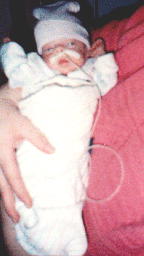
Mom holding Scott
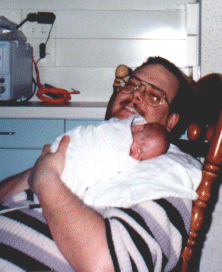
Dad holding Scott
He is at 2lb 9.5oz. Soon we will be starting "kangaroo care". This is when the mother and baby gets really close. Skin to skin. This is really a good source of bonding and also may even help stimulate the nursing mom when she is having a dry spell of her breastmilk production. Moms may go through stages where they may only produce 1 oz of milk for 2 breasts. Stress, nutrician, and other living habits could be causes of the low amount.
Scott has discovered his fingers and hands. We have been changing his diapers and checking his temps, when we are visiting him. The PIC line is still out and he also is still off antibiotics. This (PIC LINE) was put in as an access line for his nutrition.Before the baby is able to receive breastmilk or formula, he may get TPN. TPN stands for "total parenteral nutrition". This is a nutritional suppliment of all the minerals, electrolytes and fluids he needs. Once it is established that the baby can start getting nutritional fluids in his stomach, he may get them through a feeding tube or he can take from the bottle.The premature babies usually get the feeding tube.The feeding tube is put down the nose of the baby and goes directly into the stomach.This way he receives increments of feedings.Scott started out with 3cc's of breastmilk then got as high as 11 cc's.The feedings were 3 hours apart.Recently, he was taken off his breastmilk because he was getting belly distention.Distention is when the belly is rounded and looks to be "full".He was given x-rays and with them they could look for any reasons why he was distended. The x-rays showed gas mainly and fluid in his stomach.I think they have determined that the 11cc's every 3 hrs were just too much for him to handle.Also as stated before, with the Rifampin and prematurity, his digestive tract is still running a little slow. But with time his digestive tract will catch up to the rest of him and will be working fine. He will soon begin his breastmilk again but this time it will be lower amounts.It is common that the nurses and doctors don't know how much is too much.This is just a way that the baby is able to tell them when too much is too much.
There a lot of monitors and sounds that can make the parent very nervous. Some of the sounds are of medicine monitors, heart and oxygen monitors. Heat sensors, for the incubator or bed. The nurses are usually really good at helping us or explaing stuff to us, or even seeking answers when they do not have them. Parents, it is common to be nervous or even scared when the alarms go off.Just try to remain calm. :o)
It is common that we are asked to leave for a few minutes while the nurses start i.v's.. Also anytimes there are new babies coming into the unit that Scott is at, we are asked to leave. This gives the nursing staff more room and less people to deal with while they are trying to care for their new patient. We have gotten to be very patient and forgiving. Sometimes when you have worked all day and want to see your baby, it is hard to hear: "can you leave for a few minutes?" or, "can you come back in like, 15 minutes? We have a new patient." Please, be patient and allow the nurses to do their jobs. It is times like this when they are trying their best to be the best nurses they can be for every one of their patients.
We have been very fortunate that not only are we in the best neonatal hospital in this part of the state, but also the quality of Scott's nursing staff is unremarkable.
Also, a common qustion asked to me is this. When will Scott be able to go home? The answer is this. Usually premature babies go home around their due date. Scott's case is Feb 5th. So, we are looking at late January to early Febuary that he might come home if all goes well. Usually 5 lbs, although a nurse told me the other day that they seem to be going home a little lighter than that. So, he may be 4 lbs when he comes home.
Well, there is alot more in store for us I am sure.As I get more info and experiences I will try to add them to this site..I hope this site helps out anyone who is just wondering about the babies in the NICU. I can honestly say that I have learned a lot (and I even work in surgery)..
Thanks to everyones prayers and comments of encouragement for us. Anyone can email me about this topic or any questions they may have.
I also want to thank the dedicated nurses and doctors that have taken care of Scott and many other children at St.John's Hospital. They work in the best neonatal unit in Illinois. ~Lonman
![]()

![]()
February 4th, He is finally home!! Folks can read how he is doing on his other page titled, Life after the NICU.
He has received medicine to help prevent RSV. Respiratory Syncytial Virus. RSV is a respiratory virus that attacks the lungs during wintertime though the spring. We did not even know about it until our Dr. started giving the med to him. The nurses stated that usually this med is not routine and that most the time the parents are asked if they want it or they have to mention it too the Dr. if they want it given.
I felt that was really something. People need to know about this RSV. Please read more about it in my link to CLINI WEB.
He is 15wks old and weighs 5 lbs. He is 16 inches long. :o)
![]()
Scott and his brother from June, '05
First function as a wolf scout from May, '05
 "GQ" from October,'00
"GQ" from October,'00
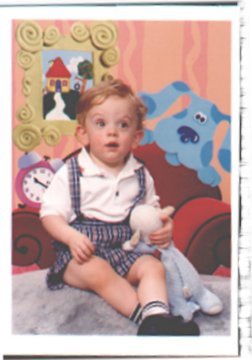 Scott's pic from July,'99
Scott's pic from July,'99
 Family pic from Christmas,'07
Family pic from Christmas,'07
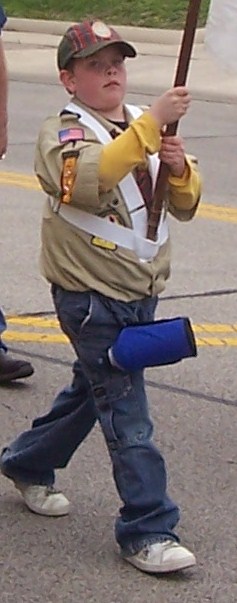 Scott, Webelo Scout at the Lincoln Pilgrimage, 2008
Scott, Webelo Scout at the Lincoln Pilgrimage, 2008
![]()
 CLICK HERE FOR PREEMIE LINKS PAGE
CLICK HERE FOR PREEMIE LINKS PAGE
